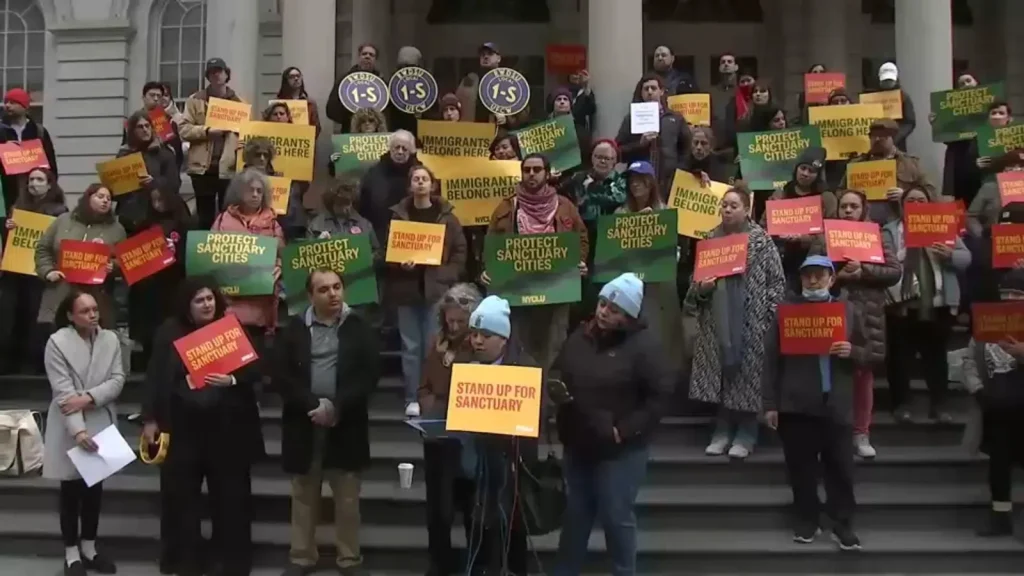The recent Justice Department lawsuit against New York City sanctuary policies has ignited a fierce debate over the city’s approach to immigration enforcement and public safety. As deportation raids increase nationwide, the lawsuit, which specifically names Mayor Eric Adams and various officials, claims that the city’s policies intentionally obstruct federal law enforcement efforts. At the center of this legal battle is New York City’s controversial stance on ICE detainers, which are not honored unless specific criminal criteria are met. Critics argue that such sanctuary city laws not only compromise law and order but also endanger local residents. With more attention on NYC immigration enforcement policies than ever, this case raises critical questions about the balance between community protection and adherence to federal immigration mandates.
The ongoing legal challenge related to New York City’s immigration support policies has become a focal point in discussions regarding local versus federal cooperation on immigration matters. As city leaders grapple with increasing crime rates, the federal government’s actions reflect a broader strategy to confront jurisdictions that have enacted provisions seen as hindering immigration law compliance. This tension encapsulates the conflicting philosophies surrounding sanctuary city regulations, particularly as they pertain to the treatment of individuals facing deportation under ICE oversight. With Mayor Eric Adams at the helm, the city faces scrutiny not only from federal authorities but also from residents concerned about safety amidst rising crime rates. This lawsuit may set significant precedents for how local governments interact with federal immigration directives, potentially reshaping the future of sanctuary policies across the United States.
Overview of the Justice Department’s Lawsuit Against NYC Sanctuary Policies
The Justice Department’s lawsuit against New York City illustrates a significant conflict between federal immigration enforcement and local sanctuary city laws. This legal action targets New York City’s policies that have historically limited cooperation with Immigration and Customs Enforcement (ICE). By naming Mayor Eric Adams and various city officials in the lawsuit, the federal government aims to reinforce the principle that immigration laws should be uniformly enforced across all jurisdictions, irrespective of local policies designed to shield undocumented immigrants.
At its core, this lawsuit challenges the premise that cities like New York can operate under sanctuary policies while hindering federal efforts to address illegal immigration. The ongoing increase in deportation raids underscores the urgency of the Justice Department’s position, particularly as officials argue that New York City’s reluctance to comply with ICE detainers compromises public safety and jeopardizes the effectiveness of immigration enforcement.
Impact of NYC’s Sanctuary Policies on Immigration Enforcement
New York City’s sanctuary policies significantly impact immigration enforcement within its jurisdiction. The city’s refusal to honor ICE detainers unless specific legal criteria are met creates a disconnect between federal immigration priorities and local enforcement practices. This practice has been consistent since 1989, yet recent years have seen heightened tension as calls for greater cooperation with federal authorities grow amidst rising crime statistics.
Critics of New York City’s immigration policies, including figures like U.S. Rep. Nicole Malliotakis, argue that these sanctuary city laws merely protect individuals who have committed crimes, ultimately compromising the safety of law-abiding residents. The Justice Department’s lawsuit seeks to dismantle these policies, reflecting a broader national debate about the effectiveness and morality of sanctuary cities in managing immigration.
Eric Adams’ Immigration Policy: A Closer Look
Mayor Eric Adams’ approach to immigration has been scrutinized amidst the ongoing lawsuit from the Justice Department. His administration has maintained the sanctuary city status, advocating for the protection of immigrants while also addressing public safety concerns. Some argue that his policies, while aimed at inclusivity, fail to address the increasing demands for collaboration with ICE, especially in the context of rising crime associated with undocumented immigrants.
Adams’ immigration strategies have sparked a dialogue about how cities should navigate the complex interplay between protecting immigrant rights and ensuring public safety. His administration faces the challenge of reconciling community aspirations with federal requirements, particularly as the lawsuit emphasizes the need for enhanced cooperation between city officials and federal immigration agencies.
The Role of ICE Detainers in New York City
ICE detainers are central to the ongoing legal battle between New York City and the Justice Department. These legal tools allow federal authorities to request that local law enforcement notify them before releasing undocumented immigrants from custody. However, NYC’s sanctuary policies limit adherence to these detainers, igniting legal disputes over the implications for public safety and federal immigration enforcement.
As the Justice Department’s lawsuit suggests, the refusal to honor ICE detainers can result in released individuals who may pose a risk to the community. This contention underscores the broader implications for cities that choose to adopt sanctuary policies, raising questions about the balance between immigration rights and the safety of local residents.
Political Reactions to the NYC Sanctuary Policies Lawsuit
The lawsuit against New York City has elicited a variety of responses from political figures and community leaders. Proponents of the lawsuit, including Attorney General Pam Bondi, argue that New York City’s sanctuary policies are misguided and dangerous. They contend that public safety should take precedence over protective measures for undocumented individuals, stating that cooperation with ICE is vital for maintaining community security.
Conversely, advocates for immigrant rights view the lawsuit as an attack on local autonomy and the rights of undocumented residents. They argue that sanctuary policies are designed to foster trust between immigrant communities and law enforcement, ultimately leading to safer neighborhoods. This dichotomy highlights the contentious nature of immigration policy discussions in New York City and beyond, as both sides seek to influence public perception and policy direction.
Historical Context of NYC’s Sanctuary Policies
New York City’s sanctuary policies have a historical foundation that dates back several decades. Originating in 1989, these policies were created in response to concerns about the treatment of undocumented immigrants within the city. Over the years, the limitations placed on local law enforcement’s cooperation with federal immigration agencies have evolved to reflect the changing political landscape and public sentiment regarding immigration.
As federal immigration enforcement has intensified in recent years, particularly under the Trump administration, New York City’s sanctuary status has come under increased scrutiny. The Justice Department’s action against NYC is not an isolated incident; it reflects a broader trend where sanctuary cities are increasingly challenged by federal authorities in courts across the country, drawing attention to the lasting implications of local immigration policy.
Public Safety Concerns Amid NYC Sanctuary Policies
Public safety is a predominant theme in the discourse surrounding New York City’s sanctuary policies. Following the increased scrutiny of these policies, law enforcement officials have raised concerns about the potential risks associated with undocumented immigrants who may be involved in criminal activities. The Justice Department’s lawsuit, together with statements from various political leaders, underscores the urgency of addressing the links between sanctuary policies and public safety.
Many argue that the refusal to comply with ICE detainers can lead to higher crime rates, as individuals released without notification may pose risks to the community. This perspective has bolstered calls for greater transparency and communication between local law enforcement and federal immigration officials, as advocates for reform stress the need for balanced policies that protect immigrant rights while ensuring public safety.
Comparative Analysis: NYC and Other Sanctuary Cities
New York City is not alone in facing legal challenges related to its sanctuary policies; similar lawsuits have emerged in other major cities, such as Los Angeles. These comparative actions highlight a nationwide trend where local governments’ sanctuary laws are increasingly at odds with federal immigration enforcement priorities. The Justice Department’s suit against NYC serves as a compelling example of how cities navigate the legal complexities of sanctuary laws.
Each sanctuary city has its unique context and rationale for adopting these policies, often rooted in historical relationships with immigrant populations. However, as federal authorities ramp up enforcement efforts, cities like New York may face mounting pressure to align their policies more closely with those at the federal level. This juxtaposition raises important questions about the future of sanctuary cities in America and the evolving landscape of immigration policy.
Future Implications of the NYC Sanctuary Policies Lawsuit
The implications of the Justice Department’s lawsuit against New York City extend far beyond the immediate legal battle. As the case progresses, it could set crucial precedents for sanctuary cities across the country, influencing how local policies are crafted in relation to federal immigration enforcement. Legal experts and policymakers are closely monitoring the developments, recognizing that the outcomes could reverberate through other jurisdictions facing similar challenges.
In the long term, this lawsuit may compel cities to reevaluate their sanctuary policies and consider the balance between protecting immigrant communities and adhering to federal mandates. Depending on the outcome, it could either embolden further sanctuary efforts or stifle them, significantly altering the landscape of immigration rights and community safety in America.
Frequently Asked Questions
What are the implications of the Justice Department lawsuit against New York City sanctuary policies?
The Justice Department lawsuit against New York City sanctuary policies seeks to challenge the city’s practices that limit cooperation with federal immigration enforcement. This case could redefine how sanctuary cities operate, potentially leading to increased compliance with ICE detainers, and affecting the immigration enforcement landscape across the U.S.
How does the NYC immigration enforcement debate relate to the Justice Department’s lawsuit?
The NYC immigration enforcement debate is central to the Justice Department’s lawsuit, which argues that the city’s sanctuary policies obstruct federal immigration law enforcement. The outcome could influence how cities balance local enforcement with federal immigration goals.
What specific sanctuary city laws are under scrutiny in the Justice Department lawsuit against New York City?
The Justice Department lawsuit highlights sanctuary city laws that prevent New York City from honoring ICE detainers without specific legal warrants, arguing these laws hinder federal immigration enforcement and pose risks to public safety.
How does Mayor Eric Adams’ immigration policy impact the Justice Department lawsuit?
Mayor Eric Adams’ immigration policy is integral to the Justice Department lawsuit, as it is designed to uphold sanctuary city principles, which the federal government argues contribute to issues of public safety by limiting cooperation with ICE.
What is the significance of ICE detainers in the context of the New York City sanctuary policies lawsuit?
ICE detainers play a crucial role in the New York City sanctuary policies lawsuit because the city’s refusal to comply with these detainers forms a basis for the Justice Department’s allegations that the city is obstructing federal immigration enforcement.
How have rising crime rates influenced the lawsuit against New York City’s sanctuary policies?
Rising crime rates have prompted criticisms of New York City’s sanctuary policies, leading some officials to demand cooperation with ICE. These concerns are cited in the Justice Department lawsuit as justification for increased federal intervention in local immigration enforcement.
What are the potential outcomes of the lawsuit challenging New York City sanctuary policies?
Potential outcomes of the lawsuit could include changes to New York City’s sanctuary policies, increased cooperation with ICE on detainers, or broader implications for other sanctuary cities if the federal court rules against NYC.
How does the Justice Department lawsuit against New York City compare to similar actions taken against other sanctuary cities?
The Justice Department lawsuit against New York City is similar to previous actions against other sanctuary cities, such as Los Angeles, indicating a broader federal strategy to challenge local policies that resist immigration enforcement amid rising national tensions.
What arguments are city leaders making in response to the Justice Department lawsuit on sanctuary policies?
City leaders are arguing that the Justice Department lawsuit undermines local laws designed to protect immigrants and enhance community trust, emphasizing that cooperation with ICE may deter immigrant communities from reporting crimes.
How could the Justice Department’s stance on New York City sanctuary policies affect future immigration enforcement strategies?
The Justice Department’s strong stance against New York City sanctuary policies could set a precedent for future immigration enforcement strategies, potentially leading to stricter regulations on local compliance and diminishing the sanctuary status of numerous cities nationwide.
| Key Point | Details |
|---|---|
| Justice Department Lawsuit | The lawsuit aims to challenge New York City’s sanctuary policies that resist immigration enforcement. |
| Defendants | New York City Mayor Eric Adams and various city officials are named in the lawsuit. |
| Historic Obstruction | New York City has a history of obstructing immigration law enforcement since 1989, with intensified efforts in recent years. |
| ICE Detainers | City policy prevents the Department of Corrections from honoring detainers issued by ICE unless there’s a judge’s warrant or specific serious crimes. |
| Federal Response | A White House spokesperson criticized sanctuary cities, emphasizing that they protect criminals and stating the Trump administration will not tolerate hindrances to federal enforcement. |
| Rising Crime Concerns | Some city leaders called for collaboration with ICE citing rising crime rates linked to illegal immigrants. |
| Political Endorsements | U.S. Rep. Nicole Malliatakis supports the lawsuit, labeling sanctuary policies as dangerous and misguided. |
| Similar Actions | The lawsuit against New York City mirrors a previous action against Los Angeles for similar sanctuary policies. |
Summary
The New York City sanctuary policies lawsuit marks a significant challenge against local jurisdictions that resist federal immigration enforcement. This legal action not only highlights the ongoing conflict between city policies and federal law but also reflects a national dialogue on public safety and immigration. As the Justice Department seeks to enforce immigration laws against these sanctuary policies, the implications for cities like New York remain profound and contentious.



